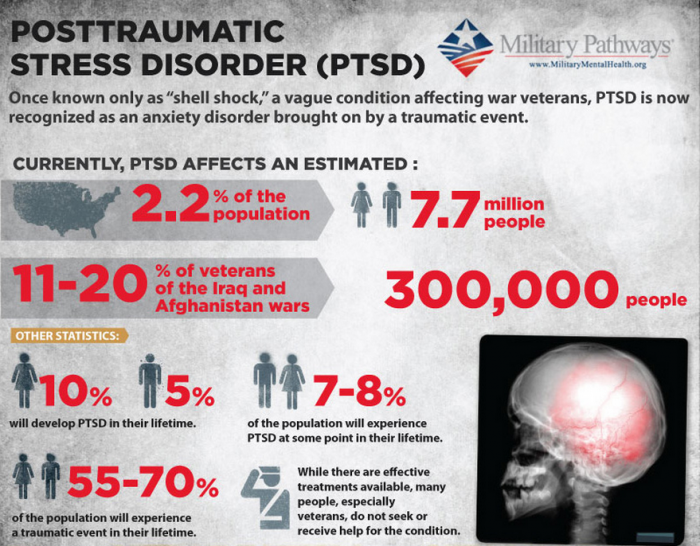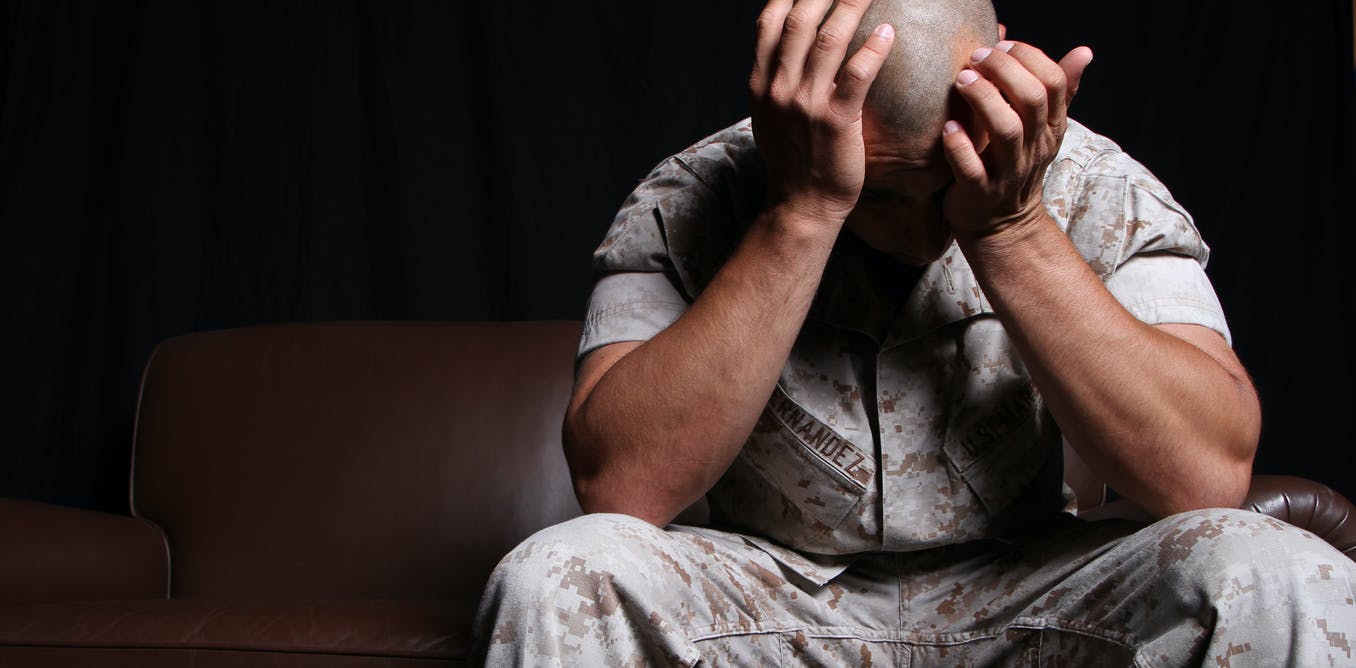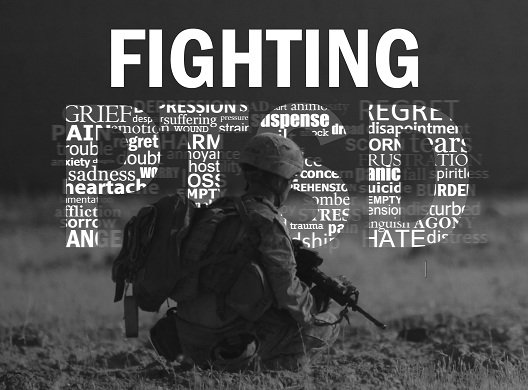Ptsd Statistics: Prevalence Among Veterans
Though many researchers have sought to understand the prevalence of PTSD among military veterans, their efforts have produced divergent PTSD statistics. Because the field of psychiatry has defined and assessed PTSD in various ways over time, estimates of prevalence vary widely.
In fact, in;one recent meta analysis;of thirty-two scientific articles,;researchers found the estimated incidence of PTSD among veterans ranged from modest figures such as 1.09% to high rates 34.84%. Clearly, determining the true prevalence of PTSD among veterans will require much further research.
However, some high-quality studies may shed some light on the matter:
- In a 2017 study;involving 5,826 United States veterans, 12.9% were diagnosed with PTSD. This is a striking high rate compared to the incidence of PTSD;among the general population: Just 6.8% of the U.S. population will experience PTSD at any point in their lives. Across the entire U.S., only about 8 million U.S. adults have PTSD in a given year.
- In a;2014 study;involving 3,157 United States veterans, 87% reported exposure to at least one potentially traumatic event.;On average, veterans reported 3.4 potentially traumatic events during their lifetime.
Resources For Service Members
In addition to these forms of therapy, the following resources can be useful for;service members and their families;who want to receive more information about different types of PTSD treatment.
Contact your family doctor. The U.S. Department of Veterans Affairs advises veterans to consult their family doctor as one way of finding an experienced trauma-care provider.
- Strong Star, a south Texasbased research organization, offers clinical trials to veterans suffering from PTSD. Though the organization primarily recruits people in Texas cities for participation in their studies, a growing number of areas outside of Texas may also be available.
- The Sidran Institute is a nonprofit organization dedicated to helping people with trauma find and locate trauma-related resources by providing referrals to therapists, treatment centers, and organizations throughout the country.
- The Military Crisis Line is a free, confidential service for all members of the military who require support. You can call the hotline or visit the website to chat with a qualified VA responder online.
Risk Factors For Ptsd In Veterans
A number of factors have been shown to increase the risk of PTSD in the veteran population, including younger age at the time of the trauma, racial minority status, lower socioeconomic status, lower military rank, lower education, higher number of deployments, longer deployments, prior psychological problems, and lack of social support from family, friends, and community . PTSD is also strongly associated with generalized physical and cognitive health symptoms attributed to mild traumatic brain injury .
You May Like: Is Anxiety A Form Of Depression
I Cant Control My Temper
This can be really scary and frustrating for many trauma survivors, especially Veterans and Active Dutymilitary personnel who have been in places where being angry or aggressive was seen as beneficial. You canlearn to control your behavior when you are upset with the help of this app and/or with in-person therapy.Check out some of the coping tools for anger in the Manage Symptoms section of the PTSD CoachCanada;Application.
Just How Prevalent Is Ptsd In The Military

The percentage of veterans affected by PTSD varies:
Operations Iraqi Freedom;and Enduring Freedom:;Between 11 and 20 percent of veterans.
Gulf War:;About 12 percent of veterans
Vietnam War: Studies suggest about 15 percent of veterans, yet its estimated that about 30 percent have had PTSD in their lifetime.
Don’t Miss: How Long To Panic Attacks Last
What Happens If We Fight Another War
In an optimistic scenario where 1 percent of all military personnel are deployed to combat zones that no war happens in the next decade, we estimate that 7 percent of military personnel and 10 percent of veterans will have PTSD by 2025.
But that could increase to 20 percent in the military and more than 11 percent among veterans in 2025 if the U.S. gets involved in a war requiring 5 percent deployment of all military personnel on battlefield. For perspective, from 2001 to 2014, on average, 6.6 percent were deployed annually. Larger wars with higher deployment rates will noticeably increase the prevalence of PTSD.
We also estimated the delay in mitigating the effects of a hypothetical war. Lets assume that the U.S. involves in a five-year war with 10 percent troop deployment .
After the end of this hypothetical war, it will take about 40 years for PTSD prevalence to go back to its initial rate. This estimation shows how long the effects of war can endure.
Ptsd Treatment For Veterans
The treatment of PTSD is multidimensional, including medication, therapy, and in recent years, mindfulness-based treatments have provided an alternative to managing both PTSD and chronic pain.
While some researchers have said that exposure therapy, which is trauma focused, is not always advisable for most veterans with PTSD, a 2019 study suggested otherwise. The study was the first to conclude that exposure therapy did not increase the risk of exacerbation of PTSD symptoms among participants.
You May Like: Why Is Life So Depressing
Ptsd In Combat Veterans
The existence of war-induced psychological trauma likely goes back as far as warfare itself, with one of its first mentions by the Greek historian Herodotus. In writing about the Battle of Marathon in 490 b.c., Herodotus described an Athenian warrior who went permanently blind when the soldier standing next to him was killed, although the blinded soldier himself had not been wounded. Such accounts of psychological symptoms following military trauma are featured in the literature of many early cultures, and it is theorized that ancient soldiers experienced the stresses of war in much the same way as their modern-day counterparts.
The symptoms and syndrome of PTSD became increasingly evident during the American Civil War . Often referred to as the countrys bloodiest conflict, the Civil War saw the first widespread use of rapid-fire rifles, telescopic sights, and other innovations in weaponry that greatly increased destructiveness in battle and left those who survived with a myriad of physical and psychological injuries.
Veterans Mental Health And Post
When it comes to veterans, mental health issues encompass a wide range. The psychological effects of war on soldiers extends beyond responses to trauma and can result in an array of other mental illnesses, including depression, anxiety, and substance abuse. Some of this is due to the experience itself, while other times, post-war mental illness is a result of a traumatic brain injury incurred during service.
Its important to note that mental illness does not only affect the veteran but their family as well. Many soldiers have spouses, and nearly half have children who are under 18. Ina review of parental deployments published in Professional Psychology: Research and Practice, researchers found a strong incidence of behavioral and psychological issues among children who had a parent who served or is serving in the military. And the stress of post-war trauma can reach even further, affecting not just children and spouses but parents, siblings, and other extended relatives.
The costs of war arent relegated solely to veterans, and this is especially true when mental illness is involved. Many of the symptoms of PTSD in particular, such as anger and isolation, have marked effects on a veterans loved ones, who may or may not understand the psychology of what is going on.
You May Like: How Early Can Schizophrenia Start
How Common Is Ptsd In Veterans
When you are in the military, you may see combat. You may have been on missions that exposed you to horrible and life-threatening experiences. These types of events can lead to PTSD.
The number of Veterans with PTSD varies by service era:
- Operations Iraqi Freedom and Enduring Freedom : About 11-20 out of every 100 Veterans who served in OIF or OEF have PTSD in a given year.
- Gulf War : About 12 out of every 100 Gulf War Veterans have PTSD in a given year.
- Vietnam War: About 15 out of every 100 Vietnam Veterans were currently diagnosed with PTSD at the time of the most recent study in the late 1980s, the National Vietnam Veterans Readjustment Study . It is estimated that about 30 out of every 100 of Vietnam Veterans have had PTSD in their lifetime.
Other factors in a combat situation can add more stress to an already stressful situation. This may contribute to PTSD and other mental health problems. These factors include what you do in the war, the politics around the war, where the war is fought, and the type of enemy you face.
Another cause of PTSD in the military can be military sexual trauma . This is any sexual harassment or sexual assault that occurs while you are in the military. MST can happen to both men and women and can occur during peacetime, training, or war.
Among Veterans who use VA health care, about:
Apps for self-help, education, and support after trauma.
Get help for PTSD
If you need help right away:
Connect with us
The Average Number Of Suicides Among Veterans Is 176 Per Day
This is the most recent data. PTSD can cause war flashbacks and acute stress disorder, among other things, which can further compel them to try to self-medicate, abuse drugs, or turn to excessive drinking instead of seeking professional medical help.;
As PTSD in veterans facts and stats show, they are 58% higher risk of committing suicide than veterans who were not diagnosed with PTSD.
Also Check: How To Get A Service Dog For Anxiety And Ptsd
Homeless Veterans Living With Ptsd
Aron Janssen, MD is board certified in child, adolescent, and adult psychiatry and is the vice chair of child and adolescent psychiatry Northwestern University.
It’s hard to imagine someone who served our country in the military living on the streets. Unfortunately, for many veterans, homelessness is a sad reality. Although theres no official count, the U.S. Department of Housing and Urban Development;estimates that nearly 40,000 veterans are homeless.
First World War: Shell Shock

The prolonged duration of the First World War, and the enormous casualty rate, saw the birth of military psychiatry.At that time, the Canadian medical profession was heavily influenced and shaped by the United States and United Kingdom. Combat-related emotional trauma became known as shell shock or lhypnose des batailles. The term shell shock capturedBritish ambivalence about whether the symptoms found in soldiers who did not show obvious wounds were of a physical or psychological nature. Dr. Donald Campbell Meyers , a neurologist who opened a psychiatry ward at the Toronto General Hospitalin 1906, came to view shell shock as a functional or traumatic neurosis.
Don’t Miss: Why Do People Develop Eating Disorders
Ptsd In Veterans Statistics
- An estimated 354 million adult war survivors globally have PTSD and/or major depression.
- In one study of 1,938 veterans, a PTSD prevalence of about 14% was present in veterans who served in Iraq. ;
- In reports, a 10% prevalence of PTSD has been extrapolated for all Gulf War veterans. ;
- About 30% of Vietnam veterans have had PTSD in their lifetime.
Cannabis Can Reduce Ptsd
More supportive data for reducing PTSD rates. A study was using an app to track the changes in PTSD symptoms prior to and after using cannabis. The results show cannabis can reduce anxiety , irritability , flashbacks , and returning thoughts .;
Apparently, both THC and CBD, combined together, create the overall therapeutic effect. On that note, more research is needed to fully understand these short term alleviations.
Also Check: Why Does Weed Give Me Anxiety
Ptsd Leads To Addiction
Without the proper tools, veterans often turn to substance abuse as a means to cope. In fact, one study of Vietnam veterans found that 74% of the veterans had co-occurring substance use disorders. For these veterans and many like them, their mental health suffered as a result of PTSD, which led to them developing issues like alcoholism and drug addiction.
But why is this such a common issue for veterans? Well, one explanation is that veterans lack community support. Veterans often struggle to readjust to civilian life, and lack of knowledge about veteran rehabilitation resources can make them feel isolated and without help. With seemingly nobody to turn to, addiction flourishes in vulnerable veteran communities.
Statistics On Ptsd Treatment And Outlook
PTSD treatment is becoming increasingly available, and PTSD treatment statistics indicate a positive outlook for treatment.One study found that as many as 46 percent of people with PTSD improved within six weeks of beginning psychotherapy. Researchers have found that as many as62 percent of people receiving medication for PTSD show improvement. The VA recognizes the need for PTSD treatment for veterans, and PTSD treatment is now available at all VA locations. There are alsonearly 200 VA locations with specialized PTSD programs.
If you or your loved one is struggling with PTSD or another mental health concern in addition to a substance use disorder,contact The Recovery Village today to learn more about ourevidence-based treatment programs available atfacilities across the country.
Check out the Nobu app to learn more about PTSD symptoms, diagnosis, and treatment, and connect with mental health professionals that can help. It is free and for anyone that is looking to reduce anxiety, work through depression, build self-esteem, get aftercare following treatment, attend teletherapy sessions and so much more. Download the Nobu app today!
- Sources
Symptoms of PTSD. Anxiety and Depression Society of America. Accessed March 21, 2019.
How Common is PTSD in Adults? U.S. Department of Veterans Affairs. Accessed June 27, 2019.
Read Also: What Does Bipolar Disorder Feel Like
Ptsd Treatment For Veterans: Whats Working Whats New And Whats Next
Miriam Reisman
More than a decade of war in the Middle East has pushed post-traumatic stress disorder to the forefront of public health concerns. The last several years have seen a dramatic increase in the number of Iraq and Afghanistan war veterans seeking help for PTSD, shining a spotlight on this debilitating condition and raising critical questions about appropriate treatment options and barriers to care.
While PTSD extends far beyond the militaryaffecting about eight million American adults in a given yearthe problem is especially acute among war veterans. Not only are recent veterans at higher risk of suffering from PTSD than those in the general population, they also face unique barriers to accessing adequate treatment. These include the requirement that they have either an honorable or general discharge to access Department of Veterans Affairs medical benefits, long waiting lists at VA medical centers, and the social stigma associated with mental illness within military communities., According to a study conducted by the RAND Center for Military Health Policy Research, less than half of returning veterans needing mental health services receive any treatment at all, and of those receiving treatment for PTSD and major depression, less than one-third are receiving evidence-based care.
What Policies Work Best
We also tried to get a sense of what policies work best at mitigating the problem of PTSD. Using the model, we examined the long-term effects of policies within the individual components of the system, the VA and the DOD, as well as across the entire system.
We found that, before and during wars, prevention interventions are the most effective policy to decrease the prevalence of PTSD. Improving resiliency can work as a vaccine or early treatment before the onset of the cascading effects of PTSD.
However, social barriers such as the stigma of PTSD are still in place, affecting willingness to receive early treatment.
Overall, our results show that in a post-war period there is no easy solution for overcoming the problem of PTSD, and the current screening and treatment policies used by the VA and the DOD must be revolutionized to have any noticeable effect.
The VA and the DOD should work together and try to offer timely service to patients. However, we showed that they cannot do much to decrease health care costs. These are the consequences of wars.
Don’t Miss: How To Deal With Someone With Ptsd
There Are High Unmet Needs But Also Opportunities For Improvement In Both Diagnosing And Treating Ptsd
Diagnosing and then treating PTSD can be nuanced due to the complexity and timing of PTS presentation, with patients having multiple symptoms arising from the symptom clusters.16
- PTSD symptoms may start within 3 months of the traumatic event, but sometimes emerge years later.
- PTSD may be substantially underdiagnosed due to comorbidities and substance abuse, stigma associated with the diagnosis, lack of awareness among physicians and patients, and a lack of screening tools.
Further Reading Suggested PTS Resources
Mayo Clinic: Post-Traumatic Stress Disorder
References
Deal With Flashbacks Nightmares And Intrusive Thoughts

For veterans with PTSD, flashbacks usually involve visual and auditory memories of combat. It feels as if its happening all over again so its vital to reassure yourself that the experience is not occurring in the present. Trauma specialists call this dual awareness.
Dual awareness is the recognition that there is a difference between your experiencing self and your observing self. On the one hand, there is your internal emotional reality: you feel as if the trauma is currently happening. On the other hand, you can look to your external environment and recognize that youre safe. Youre aware that despite what youre experiencing, the trauma happened in the past. It is not happening now.
State to yourself the reality that while you feel as if the trauma is currently happening, you can look around and recognize that youre safe.
Use a simple script when you awaken from a nightmare or start to experience a flashback: I feel because Im remembering , but as I look around I can see that the event isnt happening right now and Im not in danger.
Describe what you see when you look around .
Try tapping your arms as you describe what you see to help bring you back to the present.
Recommended Reading: What’s Good For Depression